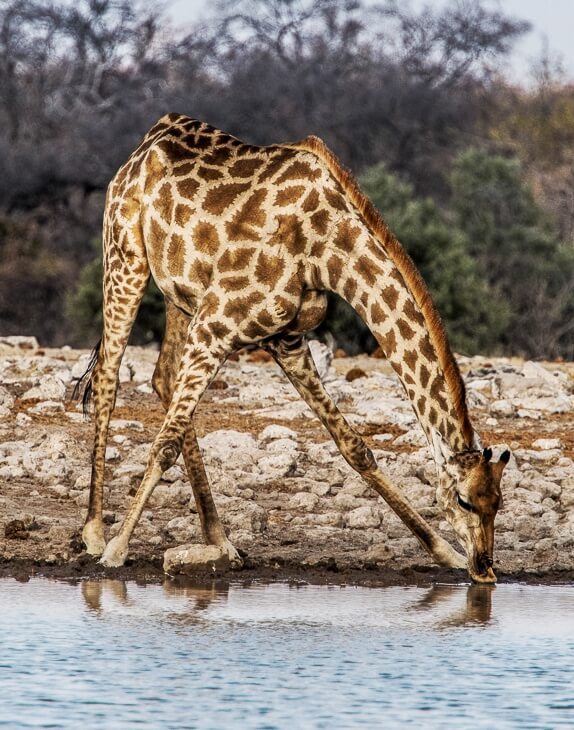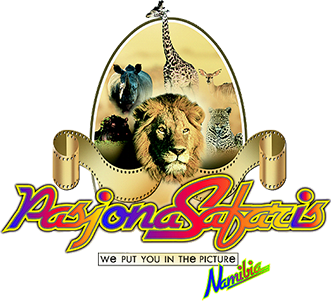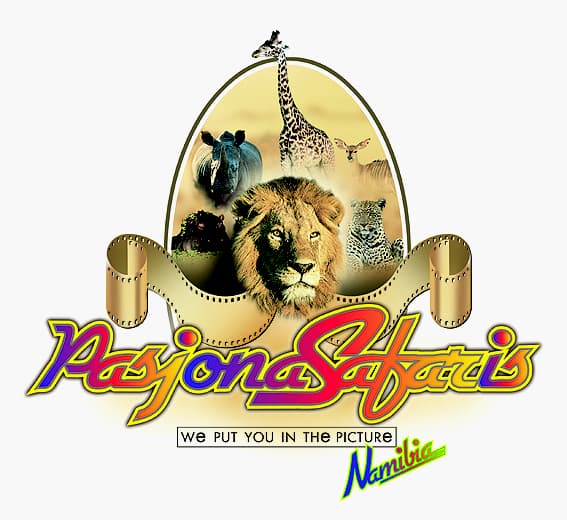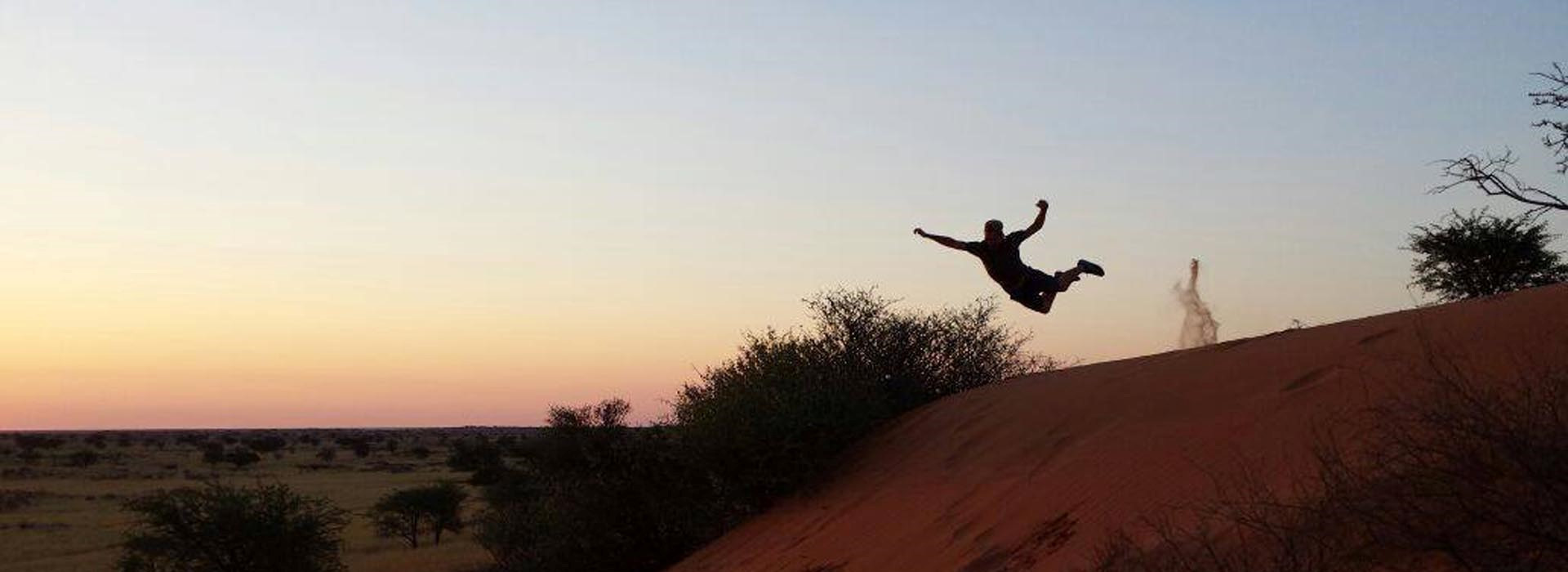
Further information
Price without flight: valid until 31 Oct 2024
N$ 47.300,00 per person in a double room incl. Vehicle
Very good middle – class accommodations have been chosen, which you can exchange with other accommodations at any time.
Price change:
All listed prices correspond to the present tariffs at the time of the tender. These prices may be changed in the short term due to unpredictable increases without the traveler being able to be notified in advance.
Services included:
- Round trip as described for 2 persons in a double room
- Transfer to / from the airport
- Car rental Toyota Corolla Cross / Suzuki or similar
- Accident & theft insurance
- Free kilometers & cool box
- 2 spare tires
- Meals as described
- Detailed travel description and maps
- Namibian VAT & tourist tax
Not included:
- Deposit for vehicle (can be reduced)
- additional insurance
- petrol
- Entrance fees to the parks
- unlisted activities and meals
All listed prices correspond to the present tariffs at the time of the tender. These prices may be changed in the short term due to unpredictable increases without the traveler being able to be notified in advance.
Self Drive Tour – Namibia
Arrival in Windhoek. You will be greeted by an employee of the Pasjona team at the airport and escorted to Windhoek. There, the formalities for the vehicle are done and handed over the vehicle. Then you can drive to your accommodation. Windhoek (Windhoek) is the largest city in Namibia with about 250,000 inhabitants and in a sense Windhoek is also the only real city in the country. The beautiful Namibian capital is situated at 1,650 meters above sea level, picturesquely in a valley surrounded by the Eros mountains in the north and the Auas mountains in the south. Towards the west, the Khomas Highlands extend towards the Namib and coast. We are happy to organize a city tour for you, in German language for the price of about 25-30 Euro, or you can take the double-decker bus in the city center with English guidance. You also have enough time to stock up on drinks and possibly some fruit for the next day.
MAISON AMBRE GUESTHOUSE or similar, B / B
Your journey starts south to the foothills of the Kalahari. If you drive south and keep to the east, you reach the foothills of the Kalahari. The Kalahari Desert (also known as “Kgalagadi”) is part of a vast sand basin that stretches from the Orange River to Angola, west to Namibia, and east to Botswana and Zimbabwe – an area of more than 1.2 million square kilometers.
DEVIL CRADLES LODGE or similar, B / B
It goes on to the south. You reach the town of Keetmanshoop via Rehoboth and Mariental. This is located about 500 kilometers south of Windhoek on the B1 / B4 and
is the traffic hub for road and rail transport and supply center for the entire south of Namibia. The city was founded in 1866 as a mission station and named after the German merchant Johann Keetman, who financially supported the mission.
Keetmanshoop today has about 20,000 inhabitants and is well suited as a stopover, as there are some comfortable hotels and guesthouses. About 13 kilometers northeast of Keetmanshoop is the spectacular, much photographed and now National Monument declared quiver tree forest on the farm Gariganus.
GESSERT GUESTHOUSE, B / B
Today you have a less long distance. In the afternoon, you can take a trip to the Fish River Canyon, which is just a few miles from your accommodation in the Conservation Park, 20 km. The Fish River is the longest river in Namibia with 650 kilometers. It rises in the eastern Naukluft Mountains and flows southwest of Ai-Ais in the Orange. The canyon at the lower reaches of the Fish River is one of the most impressive natural beauties in the southern part of Namibia. With a depth of up to 550 meters, the Fish River Canyon – after the Grand Canyon in America – is considered the second largest canyon in the world.
The gorge winds its way for about 160 kilometers through the rugged Koubis massif all the way down to Ai-Ais. The canyon starts at Seeheim. It is 161 kilometers long and ends at Ai-Ais. The canyon is part of a state nature reserve. The Restcamp Hobas contains the Parktor. From here you drive 10 km to the Canyon Rand and from there you have an impressive view of the “Hell’s Arch” (Hell’s Bend).
CANYON ROADHOUSE or similar, B / B/ D
From “Aus” you reach the guest farm Namtib on a good gravel road. Fantastically beautiful landscape awaits you. The Tiras Mountains on one side and the Namib Desert on the other side. In between you will surely also see herds of Oyx antelopes or isolated Springboks. Ostriches are also common here. In this picturesque landscape lies the farm. Here are tours in the Namib or guided hikes in the Tirasbergen.
GUEST FARM NAMTIB or similar, B / B / D
You can not get enough of this stunning landscape. You reach the highest dunes in the world. Take some time to take pictures, because this is one of the
most beautiful routes in Namibia. Your accommodation is located a few kilometers from the entrance of Sesriem.
A LITTLE SOSSUS LODGE or similar, B / B / D
You should set off already before sunrise. When the sun rises over the Naukluft mountains and the first rays of sunshine touch the dune peaks, every photographer’s heart beats faster. You have enough time to take pictures. You can climb Vlei on the Big Daddy Dune or the slightly lower one on the Sossusvlei.
The Namib is the oldest desert in the world. At first glance, you do not want to believe that anything or even anyone can exist in this landscape. Hence the naming: Namib means “empty place” or “place where nothing is”. Sandstorms and daily temperature fluctuations of 70 degrees Celsius do not invite life to linger. The starting point for the approximately 65-kilometer access to Sossusvlei is the Sesriem Camp. Another attraction in Sesriem is the Sesriem Canyon. The Tsauchab River (River: Afrikaans for river) has created here millions of years ago a gorge. Steep and almost vertical, the rock walls tower upwards, sometimes up to 30 meters. The incision is only a few meters wide. People looking for seclusion, tranquility and unspoilt nature will discover the Namib as an incomparable destination on their way to themselves. Around noon you should then make your way back, because it is still a few miles to the next accommodation.
ROSTOCK RITZ or similar, B / B / D
You cross the Namib Desert with their different faces. From the dune landscape it goes over into a stone desert up to the gypsum desert. In the distance, mountains appear out of nowhere and disappear again. Nevertheless, you can meet animals. Giraffes, zebras, oryx antelopes and ostriches, jackals and chameleons are also not uncommon. You reach the coastal town of Swakopmund The city had great importance as a port during the German colonial era, although the coastal waters are actually too shallow, a sheltered bay is missing and the surf is too strong. Lüderitz, however, was remote and had no fresh water, and the Walvis Bay seaport was then British owned. Swakopmund became the gateway to German Southwest Africa. The entire supply of the colony was handled by the small town. The cityscape of the approximately 30,000 inhabitants counting place is still characterized by numerous colonial buildings. Swakopmund is now a popular seaside resort with many tourist attractions. The climate is more pleasant than in Namibia, especially in summer. In the morning, the place on the edge of the desert is often covered in fog, which keeps the temperatures lower. Your guest house is located near the beach in a very quiet residential area.
MEIKE’S GUESTHOUSE or similar, B / B
Your next accommodation can be reached via the “Spitzkoppe”. The Spitzkoppe between Usakos and Swakopmund is also known as the “Matterhorn Namibia”. At an altitude of about 1728 meters above N.N. Spitzkoppe is by no means the highest mountain in Namibia. Because of its distinctive outlines, however, it is considered the most famous mountain in the country. Even from a very long distance you can see the island mountains in the middle of an endless, dry plain. Not far from Hohenstein lies the farm Ameib. The bidding is spectacular
Landscape. In the Phillipshöhle there are some rock paintings, among others the famous “White Elephant”. You can do nice walks. And especially interesting are the huge granite balls from Bull’s Party.
HOHENSTEIN LODGE or similar, B / B / D
A visit to the Etosha National Park is one of the highlights of a Namibia trip. Etosha covers an area of over 22,000 square kilometers and was declared a wildlife sanctuary in 1907 by the German-Southwest African administration. In the center is an extensive salt pan, surrounded by grass and thorn savannahs, mopane bush in the west and dry forest in the northeast. The pan is almost always dry. However, especially in the southern part of the park are scattered numerous waterholes, livelihood for the wildlife in the Etosha National Park. Almost the entire range of African big game is represented in the park. The Etosha National Park is well developed. Well maintained – but not paved – roads lead to the water holes, where you can observe the animals best.
OKAUKUEJO or HALALI and one night outside the park. ONGUMA BUSH LODGE or similar, B / B / D
You will spend the last day on a typical guest farm about 4 hours from Windhoek and enjoy the African flair over a campfire. However, depending on flight dates, you might have to stay overnight in Windhoek.
GÄSTFARM OHANGE D/ B / B
Today it’s time to say goodbye. A transfer will take you to the airport.



